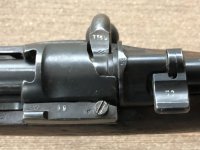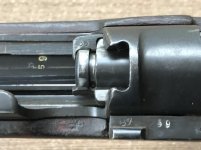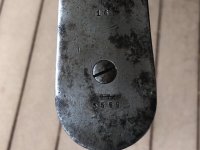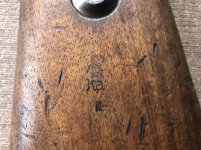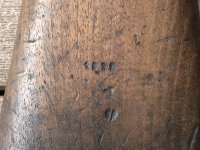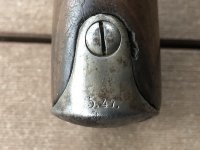This one is an odd fit. I wasn't sure if it would be more appropriate to post this in the Imperial Era sub-forum or here, but this rifle's foreign re-capture aspects make it stand out from other Kar.98's. This rifle started out as an Amberg Kar.98 produced in what appears to be 1913. The markings on the top of the receiver were mostly obliterated, making the last digit of the year stamp very difficult to determine. It is 100% matching, partly as a result of the rework processing at Posen in WWII. The bolt still retains the letters suffix on the flat.
Most of the rifle's components were acquired by Belgium, likely after WWI via reparations or open sale rather than wartime capture. Belgium acquired many ex-German and Turkish arms following the cessation of hostilities, and the components would be used on rifles like this, as well as some of Belgium's interwar Mauser variants like the Model 1935 and 1889/36. The receiver was tested by FN, as shown by the stamp on the left side of an upper case, cursive 'L' inside a flaming 'ordnance' bomb. This is the Foreign Inspection Service stamp, and was placed on foreign produced rifles and receivers by FN. It is more commonly found on those weapons that FN was sub-contracted by foreign governments to pressure and inspection test, in the absence of competent authorities and adequate facilities in the countries of origin. This marking was first used in 1924. Another Belgian inspection stamp is located next to it, of an 'F' under a five-pointed star. This is the inspection stamp of Msr. Lambert Alexandre, who worked at FN-Liege from 1927-1953. I don't know if it was (re)assembled into a complete rifle before the German invasion of 1940, or if it remained as a barreled action stored at FN or another location.
At some point following its capture after the invasion and occupation of Belgium, the components were shipped to Posen and were assembled as a whole rifle using a stock from a different Kar.98 that had been processed through the Kassel depot in WWI. This same stock remained in German possession after WWI and was '1920' stamped in accordance with IAMCC mandates of the time. Some of the smaller components were originally on other rifles, and these were renumbered to match the serial number of the barreled action. Most of those are Imperial in origin, while a few are Nazi period.
Posen stamped this rifle in two places, once with a Psn 2 stamp on the right side of the butt stock (under the WWI Kassel depot stamp) and again with a Psn 4 stamp in typical depot style on the underside of the stock. This is the only Beutewaffen I've seen with the Foreign Inspection Service stamp, and its interesting to see a foreign proofing on an originally German arm pressed back into service at a later date.
Pat
Most of the rifle's components were acquired by Belgium, likely after WWI via reparations or open sale rather than wartime capture. Belgium acquired many ex-German and Turkish arms following the cessation of hostilities, and the components would be used on rifles like this, as well as some of Belgium's interwar Mauser variants like the Model 1935 and 1889/36. The receiver was tested by FN, as shown by the stamp on the left side of an upper case, cursive 'L' inside a flaming 'ordnance' bomb. This is the Foreign Inspection Service stamp, and was placed on foreign produced rifles and receivers by FN. It is more commonly found on those weapons that FN was sub-contracted by foreign governments to pressure and inspection test, in the absence of competent authorities and adequate facilities in the countries of origin. This marking was first used in 1924. Another Belgian inspection stamp is located next to it, of an 'F' under a five-pointed star. This is the inspection stamp of Msr. Lambert Alexandre, who worked at FN-Liege from 1927-1953. I don't know if it was (re)assembled into a complete rifle before the German invasion of 1940, or if it remained as a barreled action stored at FN or another location.
At some point following its capture after the invasion and occupation of Belgium, the components were shipped to Posen and were assembled as a whole rifle using a stock from a different Kar.98 that had been processed through the Kassel depot in WWI. This same stock remained in German possession after WWI and was '1920' stamped in accordance with IAMCC mandates of the time. Some of the smaller components were originally on other rifles, and these were renumbered to match the serial number of the barreled action. Most of those are Imperial in origin, while a few are Nazi period.
Posen stamped this rifle in two places, once with a Psn 2 stamp on the right side of the butt stock (under the WWI Kassel depot stamp) and again with a Psn 4 stamp in typical depot style on the underside of the stock. This is the only Beutewaffen I've seen with the Foreign Inspection Service stamp, and its interesting to see a foreign proofing on an originally German arm pressed back into service at a later date.
Pat
Attachments
-
 5J2MnC19QFSFtzYttR3GHg.jpg295.1 KB · Views: 53
5J2MnC19QFSFtzYttR3GHg.jpg295.1 KB · Views: 53 -
 1yQ87FpUSd+%68cX8e692Q.jpg311.3 KB · Views: 41
1yQ87FpUSd+%68cX8e692Q.jpg311.3 KB · Views: 41 -
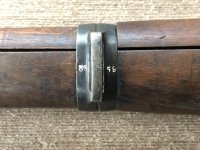 SQy4wVEZSRedFeTVzUoUXw.jpg291.5 KB · Views: 37
SQy4wVEZSRedFeTVzUoUXw.jpg291.5 KB · Views: 37 -
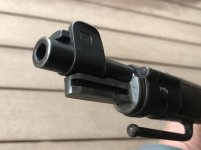 gEMtifKPS4qNVhqF6FIWVQ.jpg286.4 KB · Views: 36
gEMtifKPS4qNVhqF6FIWVQ.jpg286.4 KB · Views: 36 -
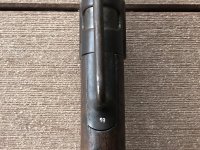 lYv6DgAcQF6mplohz17wJw.jpg324.5 KB · Views: 40
lYv6DgAcQF6mplohz17wJw.jpg324.5 KB · Views: 40 -
 WSp7aryPSZu1onKxHkWZPQ.jpg276.5 KB · Views: 34
WSp7aryPSZu1onKxHkWZPQ.jpg276.5 KB · Views: 34 -
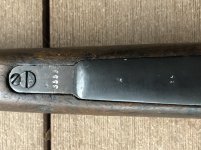 9VFCq11OSBWflgahSIf8Xw.jpg293 KB · Views: 38
9VFCq11OSBWflgahSIf8Xw.jpg293 KB · Views: 38 -
 pCF7tgybTD+VHS5ODy8qnA.jpg285.5 KB · Views: 38
pCF7tgybTD+VHS5ODy8qnA.jpg285.5 KB · Views: 38 -
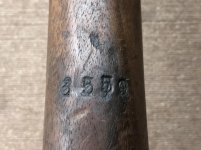 %ZbIDNHwRjmWNWd1kkVQ5w.jpg285.4 KB · Views: 54
%ZbIDNHwRjmWNWd1kkVQ5w.jpg285.4 KB · Views: 54



